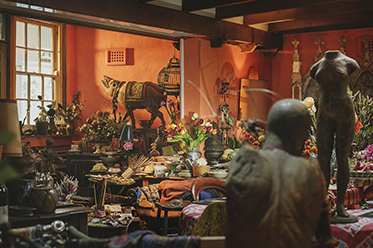 Margaret Hannah Olley was one of Australia’s most loved artists, a highly respected painter and patron who spent many of her childhood years in the Northern Rivers.
Margaret Hannah Olley was one of Australia’s most loved artists, a highly respected painter and patron who spent many of her childhood years in the Northern Rivers.
Born in Lismore on 24 June 1923, Margaret spent the first two years of her life on the family’s property at Horseshoe Creek, near Kyogle, before the family moved to Tully, hoping to be involved in a proliferation of sugar cane farms in Far North Queensland. The family returned back to the Northern Rivers in 1931, purchasing a sugar cane farm on the banks of the Tweed River at Tygalgah, near Murwillumbah.
The family moved briefly to Brisbane before returning to Tully, though Margaret remained in Brisbane to attend the boarding school Somerville House, where her talent for painting and drawing was noticed by art teacher Caroline Barker. Ms Barker was so impressed she persuaded Margaret’s parents to send their daughter to art school to further her studies.
Margaret Olley was a larger-than-life figure in the Australian art scene, as famous for her gregarious zest for life and her generosity as a patron and benefactor for the arts as she was for her colourful still-life paintings. Her artworks featured at more than 90 solo exhibitions, treasured for her intimate style of painting which she really started to develop when she left home to attend art school and further her studies.
Olley began classes at Brisbane Central Technical College in 1941 and two years later moved to Sydney and enrolled in an art diploma course at East Sydney Technical College, where she graduated with A-class honours in 1945. She then quickly became involved in the post-war Sydney art scene, which included artists such as Jean Bellette, William Dobell, Russell Drysdale, Donald Friend, Sidney Nolan, Justin O’Brien and David Strachan.
Olley held her first solo exhibition at the Macquarie Galleries in 1948, the same year Dobell painted an Archibald Prize-winning portrait of Olley dressed in a gown fashioned from parachute silk and a hat adorned with flowers. She made her first international foray the following year, living in France and travelling extensively to Spain, Brittany, Venice, Lisbon and London.
When her father died in 1953, Olley returned to her mother’s home to live and paint and she remained in Brisbane for 10 years, painting for exhibitions, designing theatre sets and murals, and opening an antique shop in Stones Corner.
She gave up alcohol in 1959 and her creative output and wellbeing increased as a result. This was the beginning of decades of commercial success with galleries and collectors, enabling her to invest in properties in Sydney and Newcastle and giving her the independence to continue to paint, travel and eventually become a benefactor to artists and public galleries.
Olley established the Margaret Olley Art Trust in 1990, to acquire paintings for public collections, the same year the first retrospective of her work was held at the S.H. Ervin Gallery in Sydney in 1990, accompanied by the launch of a monograph written by Christine France. It was followed by a retrospective exhibition at the Art Gallery of NSW (AGNSW).
Olley was appointed an Officer Order of Australia (AO) in 1991 and a Companion of the Order of Australia (AC) in 2006. AGNSW made her Life Governor of the gallery in 1997 and named the Margaret Olley, Twentieth Century European Gallery in her honour in 2001. Ben Quilty’s portrait of Olley won the 2011 Archibald Prize.
Olley who died in her Sydney home on 26 July 2011, expressed her wish to have her studio and elements of her home and collections re-created at the Tweed Regional Gallery in Murwillumbah. The Gallery was a natural choice of location for Margaret, who loved the Gallery – recognising it as one Australia’s leading regional galleries – and who spent her childhood years in the area.
Trustee Philip Bacon AM said: “Margaret Olley’s interest in regional galleries, and the Tweed River Art Gallery in particular, makes this project especially attractive to the Trustees.”
A formal offer of $1 million from the Trust set in motion several measures to source the remaining funds for the Margaret Olley Art Centre (MOAC), which will cost just over $4 million to construct as a purpose-built extension of the Gallery and includes re-creations of three of the rooms in Margaret’s famous Sydney home, including the Hat Factory and the Yellow Room where she spent many hours painting.
Project Coordinator Sally Watterson spent a year cataloguing, cleaning and packing nearly 76,000 items in rooms with barely enough room for one person to move – jammed between a celebrated lifetime of furniture, piles of books and other items including flowers and fruit made famous in Margaret Olley’s still-life paintings.
The work in Olley’s Paddington home was highly intricate, meticulous and, therefore, mentally demanding. Attention to detail included monitoring light in the room so it could be recreated at the Margaret Olley Art Centre.
The Margaret Olley Art Centre will be officially opened by Her Excellency, the Honourable Quentin Bryce AC CVO, Governor-General of the Commonwealth of Australia on Saturday 15 March before opening to the public on Wednesday 18 March.
For more information, visit: www.artgallery.tweed.nsw.gov.au for details.
Image: Interior view of the Hat Factory recreation at the Margaret Olley Art Centre
